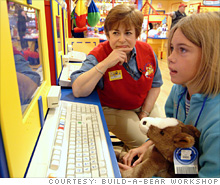How Build-a-Bear invented a bear market
A toy retailer thrives by thinking like a kid.
 |
| Build-a-Bear founder Maxine Clark |
 |
| Build-a-Bear rings in at the New York Stock Exchange |
 |
| Adults were skeptical of the Build-a-Bear concept, but children got it right away. |
(Fortune Small Business) -- Cute sells: Stuffed animals are a $1.5 billion industry in the U.S. Commanding nearly a third of that market is Build-a-Bear Workshop, a St. Louis-based retailer that lets customers personalize plush teddies, bunnies and other fuzzy friends. Founder Maxine Clark got the idea for the company in the mid-1990s while toy shopping with a 10-year-old girl who suggested that she and Clark could make their own stuffed animals.
The first Build-a-Bear Workshop debuted in 1997 at the St. Louis Galleria. Since then about 400 additional stores have opened around the world, mainly in malls. Build-a-Bear's 4,800 employees have sold more than 75 million toy animals to date. In 2004 the company went public. In 2008 revenues hit $468 million. Clark, 60, tells Fortune Small Business how she did it.
Before becoming an entrepreneur, I spent 19 years working in merchandise development, planning and research for May Department Stores. From 1992 to 1996 I served as president of Payless ShoeSource. Although I loved working for big companies, I was ready for a change; I wanted to have more fun.
Early in my career, Stanley Goodman, who was then CEO of May, said something that has stuck with me: "Retailing is entertainment, and when customers have fun, they spend more money." I wasn't sure what I wanted to do, but I knew it would involve children, because kids know how to enjoy themselves.
I may not have invented the idea of making a stuffed animal, but I did provide a venue for it. When I started Build-a-Bear Workshop, most malls had little to offer children. The stuffed-animal business was mostly seasonal, but I didn't let the way others made or sold stuffed animals deter me. Our concept was based on customization and guest entertainment.
Adults told me my idea wouldn't work. "Who wants to make their own stuffed animals?" they argued. But every kid said, "Where is it? When can I do it?"
I spent almost a year researching, writing and redefining the business plan. The initial $1 million investment came from my personal savings. How can you expect someone else to fund your company if you're not willing to ante up? However, I benefited from early publicity. While we were building our first store, COMING SOON signs prompted a St. Louis Business Journal story about Build-a-Bear's unique hands-on concept.
The article caught the eye of Barney Ebsworth, who owned a private investment firm in St. Louis. Ebsworth and his partner, Wayne Smith, invested in Build-a-Bear. Their financial support gave me a tremendous advantage.
We knew we had a winner in our first year, when we achieved more than double our projected sales. We grew quickly after that. By the end of 1998 we had four stores. Our biggest leap came between 1999 and 2000, when we went from 14 stores to 39. In 2005 we opened our 200th store, at the Mall of America in Bloomington, Minn.
When customers create toys at Build-a-Bear Workshop, they make something that is theirs alone. The experience is about self-expression and creativity. At Build-a-Bear it's all right to act like a kid. That's appealing to people who are 10 or 60. ![]()
-
The Cheesecake Factory created smaller portions to survive the downturn. Play
-
A breeder of award-winning marijuana seeds is following the money and heading to the U.S. More
-
Most small businesses die within five years, but Amish businesses have a survival rate north of 90%. More
-
The 10 most popular franchise brands over the past decade -- and their failure rates. More
-
These firms are the last left in America making iconic products now in their twilight. More









